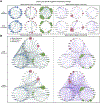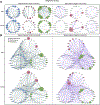Social Cognitive Networks and Social Cognitive Performance Across Individuals With Schizophrenia Spectrum Disorders and Healthy Control Participants
- PMID: 33579663
- PMCID: PMC9289871
- DOI: 10.1016/j.bpsc.2020.11.014
Social Cognitive Networks and Social Cognitive Performance Across Individuals With Schizophrenia Spectrum Disorders and Healthy Control Participants
Abstract
Background: Schizophrenia spectrum disorders (SSDs) feature social cognitive deficits, although their neural basis remains unclear. Social cognitive performance may relate to neural circuit activation patterns more than to diagnosis, which would have important prognostic and therapeutic implications. The current study aimed to determine how functional connectivity within and between social cognitive networks relates to social cognitive performance across individuals with SSDs and healthy control participants.
Methods: Participants with SSDs (n = 164) and healthy control participants (n = 117) completed the Empathic Accuracy task during functional magnetic resonance imaging as well as lower-level (e.g., emotion recognition) and higher-level (e.g., theory of mind) social cognitive measures outside the scanner. Functional connectivity during the Empathic Accuracy task was analyzed using background connectivity and graph theory. Data-driven social cognitive networks were identified across participants. Regression analyses were used to examine network connectivity-performance relationships across individuals. Positive and negative within- and between-network connectivity strengths were also compared in poor versus good social cognitive performers and in SSD versus control groups.
Results: Three social cognitive networks were identified: motor resonance, affect sharing, and mentalizing. Regression and group-based analyses demonstrated reduced between-network negative connectivity, or segregation, and greater within- and between-network positive connectivity in worse social cognitive performers. There were no significant effects of diagnostic group on within- or between-network connectivity.
Conclusions: These findings suggest that the neural circuitry of social cognitive performance may exist dimensionally. Across participants, better social cognitive performance was associated with greater segregation between social cognitive networks, whereas poor versus good performers may compensate via hyperconnectivity within and between social cognitive networks.
Keywords: Empathic accuracy; Functional connectivity; Graph theory; Research domain criteria; Schizophrenia spectrum disorders; Social cognition.
Copyright © 2020 Society of Biological Psychiatry. Published by Elsevier Inc. All rights reserved.
Conflict of interest statement
The authors report no biomedical financial interests or potential conflicts of interest.
Figures





References
-
- Green MF, Horan WP, Lee J (2015): Social cognition in schizophrenia. Nat Rev Neurosci 16:620–631. - PubMed
-
- Fett AK, Viechtbauer W, Dominguez MD, Penn DL, van Os J, Krabbendam L (2011): The relationship between neurocognition and social cognition with functional outcomes in schizophrenia: A meta-analysis. Neurosci Biobehav Rev 35:573–588. - PubMed
Publication types
MeSH terms
Grants and funding
LinkOut - more resources
Full Text Sources
Medical

